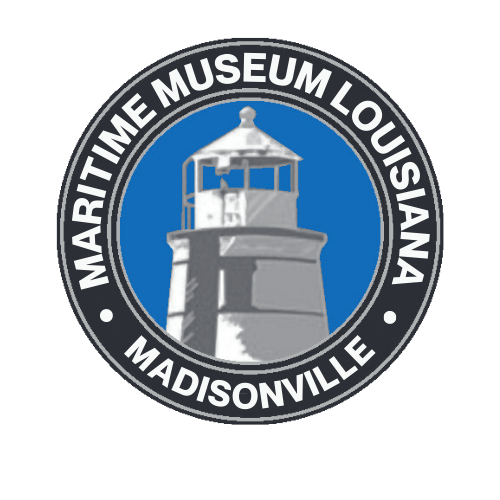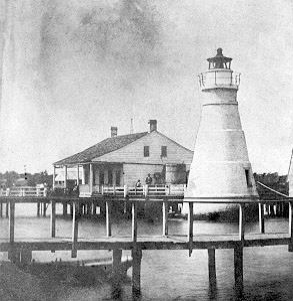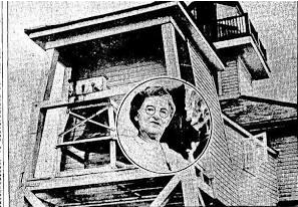Lighthouses of the Lake Pontchartrain Basin- Part A
On September 14, 1716, the first lighthouse in America was lit. Termed the Boston Lighthouse, it was located on Little Brewster Island one mile north of Point Allerton such that the two landmarks defined the entrance to Boston Harbor. Many lighthouses were to follow, some to guide ships into harbors and others to guide ships away from shoals and other hazards. While different conditions prevailed along Gulf Coast and the Lake Pontchartrain Basin compared to the Atlantic Coast, there was nevertheless a similar need for such beacons to guide mariners particularly because of the early lack of accurate navigation charts.
Let’s start in the backyard of the Lake Pontchartrain Basin Maritime Museum in Madisonville. Residents of New Orleans, possibly travelling on ferries from either Bayou St. John or Point Pontchartrain at Milneburg would undertake excursions to the north shore of the Lake, specifically Madisonville. To guide vessels into the Tchefuncte River, a 36- ft lighthouse was constructed in 1837 near the mouth of the river to guide vessels into the river. In 1857, the lighthouse was equipped with fifth-order Fresnel lens. Fifth- and six-order lenses were used in smaller bodies of water in the US.
Having been severely damaged during the Civil War, a new 10 ft higher tower was constructed on the original foundation in 1867. Over subsequent years, the lighthouse and related structures including the lighthouse keeper’s house sustained damage from storms and hurricanes requiring frequent maintenance. The year 1937 saw the loss of a resident lighthouse keeper but it was not until 1952 that the lighthouse became fully automated. In 1999, the Town of Madisonville took ownership of the lighthouse and entered into an agreement with the Lake Pontchartrain Basin Maritime Museum to act as a steward of the site. Acting in concert, the City and Museum were able to restore the finish on the exterior masonry and the interior spiral staircase. In advance of the partnership between the City and the Museum, the lighthouse keeper’s house was sold to a private individual, moved into the City, restored and used as a private residence until 2004 at which time it was donated to the City and moved to the grounds of the Museum.
The Port Pontchartrain Lighthouse at Milneburg was one of three lighthouses located on the south shore, the other two being the Bayou St. John Lighthouse and the New Basin Canal Lighthouse. In 1834, Congress authorized its construction to a height of 18 ft. At the urging of the Pontchartrain Railroad, a new octagonal lighthouse rising to a height of 28 ft was constructed three years later. As of the early 1850’s the lighthouse was already in poor condition prompting Congress to allocate funds for a new lighthouse in 1854. The new lighthouse was a brick tower located approximately 2,100 ft from shore. The tower was constructed on a concrete pad supported by pilings driven into the soil underlying the lake waters. When completed in 1855 and like the Tchefuncte River lighthouse, it was equipped with fifth-order Fresnel lens. The lighthouse was reported to be the only operational lighthouse in the Basin during the Civil War. During that period, the old octagonal structure was dismantled, and the boards were used for walkways. The lighthouse stands today in the University of New Orleans Research and Technology Park.
Of note is the fact that three women served as lighthouse keepers at the Port Pontchartrain lighthouse. The story behind one keeper, Margaret R. Norvell, is so intriguing as to interrupt my lighthouse coverage to address her life and contributions to lighthouse keeping.
Drawing from an article that appeared in The Morning Tribune, a paper published in New Orleans during the years 1924-1937, we get insight into the life of Norvell. Born Margaret Celeste Dimitry Ruth in Washington, DC, February 1860, she grew up and lived in New Orleans. In 1883, she married Louis Gray Norvell, the son of a prominent St. Louis family. Financial setbacks caused Norvell to secure a position with the United States Lighthouse Board and was subsequently posted as a lighthouse keeper to the Head of Passes lighthouse on Deer Island at the mouth of the Mississippi River. He drowned in 1891 trying to rescue seamen during a storm. While not normally employing women as lighthouse keepers, the Board had a policy that allowed wives to assume the position in the circumstances of their husbands’ death while serving as a keeper. Such employment was one of the first non-clerical US government jobs open to women.
Note: The US Lighthouse Board was de-established in 1903 and replaced with the US Lighthouse Service, also known as the Bureau of Lighthouses. In 1939 it was merged into the United States Coast Guard.
It was typical for the wives of lighthouse keepers to engage in most if not all of the duties of their husbands. This circumstance effectively eliminated the need to train replacements. Having two children at the time and little to no alternative job prospects, Margaret assumed the position of keeper (one reference I found indicated assistant keeper) at the Head of Passes lighthouse. She held that position until 1896 at which time she transferred to Port Pontchartrain as the lighthouse keeper. Norvell served at this post until 1924 during which time she experienced and survived two major hurricanes. In a 1903 hurricane she is reported to have sheltered and fed over two hundred people rendered homeless by the storm. Even in good weather, Madge, as she was called, “regularly hosted outings for Sisters of Charity, the poor and the blind at the Lighthouse” (Margaret Norvell - Clio (theclio.com)
Her third and final posting as a lighthouse keeper was at the New Basin Canal Lighthouse located on the south shore at the entrance to the canal. She remained in this post until 1932, after which she retired after a total of 41 years of service. During this posting she is credited with saving a Naval airman whose airplane had gone down in the Lake. According to the account, she launched her boat and rowed to the crash survivor. Battling a squall, it took her more than two hours to return the two of them to safety.
Of her career as a lighthouse keeper, she is reported to have said “There isn’t anything unusual in a woman keeping a light in her window to guide men folks home. I just happen to keep a bigger light than most women because I have got to see that so many men get safely home.” (lighthousefriends.com)
In recognition of her distinguished service as a lighthouse keeper, Norvell was honored in 2013 by the christening of the Sentinel-class Coast Guard Cutter as the Margaret Norvell. Interestingly, Bollinger Shipyards of Lockport, LA, was the ship builder.
While an early lighthouse keeper, Norvell was by no means the earliest female lighthouse keeper. That honor goes to Hannah Thomas who took over from her husband John Thomas in 1776 during his service in the Revolutionary War. Of notable female lighthouse keepers, Ida Lewis (shown here) is particularly noteworthy for her 54-year tenure at Newport’s Lime Rock Lighthouse. She is credited with saving up to 25 lives for which she was awarded a Congressional Medal.
The New Basin Canal Lighthouse or simply the New Canal Lighthouse was constructed in 1838 on a fill of oyster shells contained by sheet piles. Recall that the New Basin Canal, also completed in 1838, effectively replaced the Bayou St. John-Carondelet water transport route to the French Quarter. Built using cypress, the octagonal structure reached a height of about 28 ft. By 1855, the original structure had deteriorated so badly that it was replaced with a square wood structure (shown to the left) on screw piles. It was equipped with an iron lantern and 5 th Order Fresnel lens. The structure was replaced again in 1890 (shown to the right) and the light raised to 49 ft. Again in 1901, the structure was substantially rebuilt. Hurricane damage in 1903, 1915, 1926, and 1927 resulted in the need for continual maintenance efforts to ensure the continued operation of the lighthouse. Following the 1927 hurricane, the structure was raised on concrete piers.
The lighthouse keeper at that time was Madge Norvell who transferred to the New Canal Lighthouse from the Point Pontchartrain Lighthouse in 1924. She was to remain in this post until 1932. Starting in the 1960’s and extending into early 2000, the lighthouse served as a US Coast Guard Station. Severely damaged by Hurricane Katrina in 2005, it wasn’t until 2013 that the lighthouse was fully restored. The lighthouse is listed on the National Register of Historic Places and now functions as the New Canal Lighthouse Museum and Education Center by the Lake Pontchartrain Basin Foundation.
In 1808, Congress authorized $2000 to build the lighthouse at the entrance to Bayou St. John. As such, it would be the first lighthouse in the US built outside the original 13 colonies. This congressional action is an implicit indication of the importance of New Orleans to both domestic and international trade of a developing nation. Recall from an earlier Brief of the critical importance of the bayou and its extension via the Carondelet Canal (completed in 1796) to the French Quarter to passenger and commerce transport to the City of New Orleans. The octagonal lighthouse, completed and operational in 1811, was constructed on an artificial island. The lighthouse was originally equipped with sixth order Fresnel lens. The sketch shown here was made by the French artist Charles Alexander Lesueur in 1830. Shown exiting the Bayou are a two-masted schooner and a steam-powered vessel. There appears to be a rowboat in the foreground. The lighthouse was destroyed by an 8-ft surge of the “Racer’s Storm” of October 1837. In 1838, Congress authorized the construction of a new 48-ft tower and light. As of 1854, the tower was sagging and had to be reinforced and was ultimately replaced with a screw pile tower in 1856. A gale on August 11, 1860, resulted in the complete destruction of the lighthouse and it wasn’t until 1869 that the lighthouse was rebuilt on the original screw piles and placed back in operation. Operation of the lighthouse was discontinued in 1878.
The lighthouses discussed herein played a vital role in the development of New Orleans and, for that matter, the entire Lake Pontchartrain Basin. However, they represented only a subset of the system of lighthouses that contributed to safe navigation in the Basin and The Rigolets. Part B of this brief addresses the remainder of the system of lighthouses that guided mariners within the region. Part C will focus on the system of lighthouses located throughout the northern Gulf Coast.
Sources
Tannian, Kate. "Margaret Norvell." Clio: Your Guide to History. June 4, 2020.
Bayou St. John Light > United States Coast Guard > Article Listings (uscg.mil)
Tchefuncte River Light House Tchefuncte River Lighthouse, Louisiana at Lighthousefriends.com
Point Pontchartrain Lighthouse Port Pontchartrain Lighthouse, Louisiana at Lighthousefriends.com
Female Lighthouse Keepers Women Lighthouse Keepers (uscg.mil)
Brilliant Beacons, Eric Jay Dolin, Liveright Publishing Corporation, New York, 2016.
New Canal Light, Wikipedia New Canal Light - Wikipedia
Bayou St. John, 1708- 2018, Louisiana Landmark Society, University of Louisiana at Lafayette Press, 2018.












